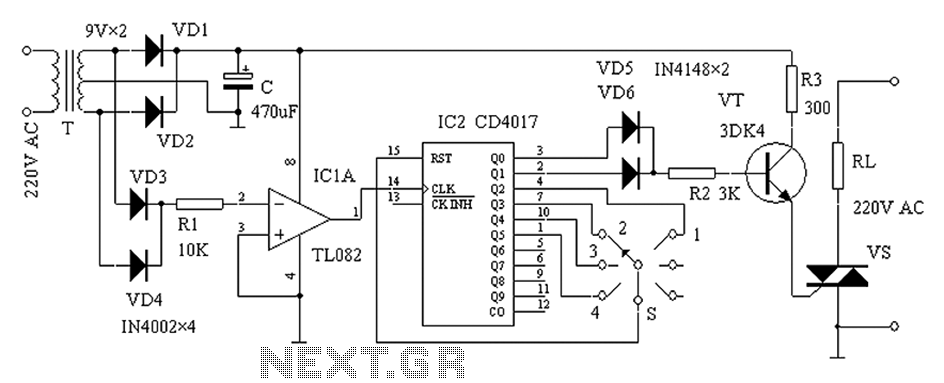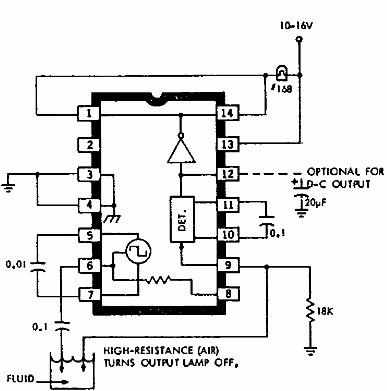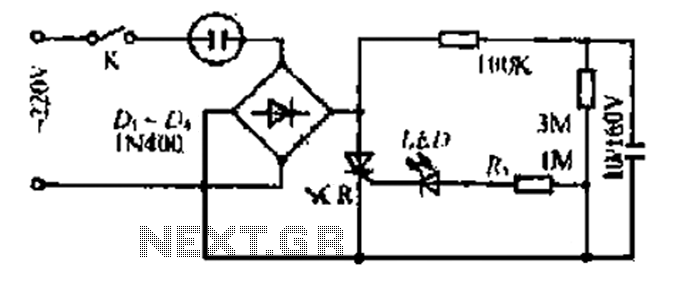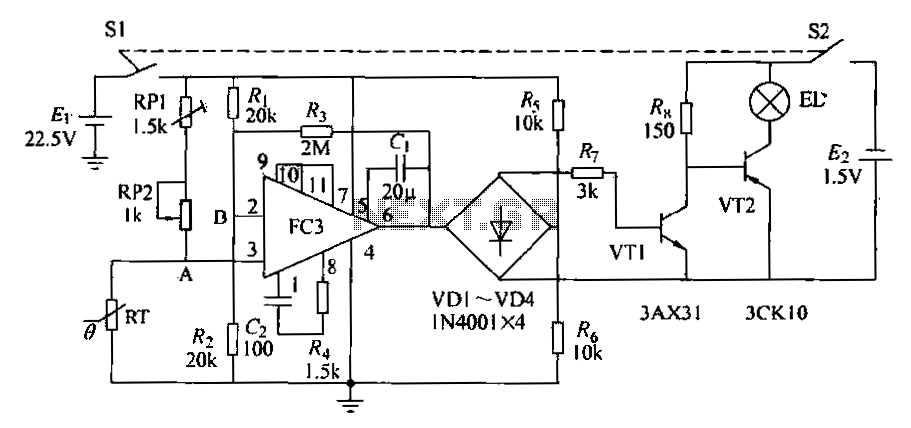
Zero-power regulator circuit diagram

The zero-power regulator circuit is simple, reliable, and functional. It is suitable for various electric power adjustment applications, such as series-wound motor power adjustment. The operational principle of the circuit involves several components, including the power circuit, an AC zero-crossing detection circuit, a decimal counter/pulse distributor, and a triac. The circuit is powered by a 220V mains transformer (T), followed by a full-wave rectification using diodes VD1 and VD2, and a filtering capacitor (C) to supply the entire circuit. Pulsating DC voltage is obtained through diodes VD3 and VD4, which is then applied via resistor R1 to the inverting input of operational amplifier IC1. When the AC voltage reaches zero, IC1 generates a zero pulse. IC2 counts these zero-crossing pulses and allocates them to produce SCR trigger signals. The power adjustment switch (S) modifies the AC load change, influencing the count of IC2. For instance, if switch S is set to the third position, IC2 will generate two trigger pulses for every four zero-input pulses, effectively reducing the power to half. The circuit can achieve four different power levels due to IC2 having ten outputs, allowing various combinations to obtain distinct power profiles. The transistor VT acts as a high-current switch, enabling reliable operation of the thyristor VS with large current triggers. IC1 can be a standard operational amplifier integrated circuit, such as LM324N or TL082, while IC2 can be a CD4017. The transistor VT can be a medium-power switching transistor like 3DK4 or equivalent, rated for at least 100V. The thyristor VS should be selected based on the load current, with a voltage rating of no less than 600V, and for inductive loads, the withstand voltage should be higher. The transformer T should be a 2-3W unit with a secondary voltage of 9V. The power adjustment switch S is typically a ceramic band switch. Other components can be selected based on the specified values in the schematic.
The zero-power regulator circuit operates effectively by leveraging the principles of zero-crossing detection and pulse counting, making it an ideal solution for applications requiring precise power control. The integration of components such as operational amplifiers and counters allows for a versatile design that can be adapted to various load requirements. The use of a triac for power control enables efficient handling of AC loads, providing a robust and reliable operation.
The circuit begins with the AC mains voltage being transformed down to a lower level by the transformer T, which is crucial for safely powering the subsequent components. The full-wave rectification performed by diodes VD1 and VD2 converts the AC voltage into pulsating DC, which is then smoothed by the capacitor C. This process ensures that the operational amplifier IC1 receives a stable voltage for accurate zero-crossing detection.
Operational amplifier IC1 is configured in an inverting manner, where it detects the zero points of the AC waveform. This detection is critical as it generates a pulse whenever the input voltage crosses zero, allowing IC2 to count these events. The CD4017 counter is particularly suited for this application as it can handle multiple outputs, facilitating the generation of various trigger signals based on the position of the power adjustment switch S.
The triac, in conjunction with the selected thyristor VS, provides a means to control the power delivered to the load. By adjusting switch S, the user can select different power levels, effectively modulating the output based on the operational requirements. This flexibility is essential for applications such as motor speed control or light dimming, where varying power levels are necessary.
The design's robustness is further enhanced by the careful selection of components rated for the expected load conditions, ensuring longevity and reliability in operation. Overall, this zero-power regulator circuit exemplifies an efficient and adaptable solution for power management in various electronic applications. As shown in the zero-power regulator circuit is simple, reliable and able to work. It is suitable for all kinds of electric power adjustment appliance, series wound motor power adjustment and the like. Circuit operation principle of the device as shown, it is from the power circuit, the AC zero-crossing detection circuit, decimal counter/pulse distributor and triac and other components. After the 220V mains power transformer T Buck, diode VD1, VD2 rectified full wave rectifier circuit constituted by the C filter is supplied after the whole circuit.
Via diode VD3, VD4 full-wave rectified, obtained after the pulsating DC voltage by R1 applied to the inverting input of the operational amplifier IC1 is. When the zero-ripple voltage (AC voltage is zero), IC1 then there have been zero pulse. IC2 pulse for counting and allocation of zero-crossing pulses to generate SCR trigger signal. S is the power adjustment switch to adjust the power AC load change IC2 counting by S. For example, when the S in the 3 file, IC2 carried quaternary counted every four zero-input pulse produces only two trigger pulse to trigger the triac turned on, so that the file for the half-power profile.
The figure shows a 4-speed, due to the IC2 with 10 outputs, the appropriate combination of these outputs, you can get different power profiles. VT connected as a high-current switch, different flows through the thyristor VS large current trigger, thus making it work reliably.
Wherein IC1 adopt a common operational amplifier integrated circuit (eg LM324N, TL082 etc.). IC2 use CD4O17. VT use 3DK4 or other medium power switching transistor can, 1OO. VS should be selected based on the current load, the pressure of not less than 600V, inductive load withstand voltage value can be increased. T uses 2 ~ 3W power transformer secondary electric pressure 9V. S selector switch for the power adjustment, optional ceramic band switch. No special requirements other components, according to the illustrated value selection.
The zero-power regulator circuit operates effectively by leveraging the principles of zero-crossing detection and pulse counting, making it an ideal solution for applications requiring precise power control. The integration of components such as operational amplifiers and counters allows for a versatile design that can be adapted to various load requirements. The use of a triac for power control enables efficient handling of AC loads, providing a robust and reliable operation.
The circuit begins with the AC mains voltage being transformed down to a lower level by the transformer T, which is crucial for safely powering the subsequent components. The full-wave rectification performed by diodes VD1 and VD2 converts the AC voltage into pulsating DC, which is then smoothed by the capacitor C. This process ensures that the operational amplifier IC1 receives a stable voltage for accurate zero-crossing detection.
Operational amplifier IC1 is configured in an inverting manner, where it detects the zero points of the AC waveform. This detection is critical as it generates a pulse whenever the input voltage crosses zero, allowing IC2 to count these events. The CD4017 counter is particularly suited for this application as it can handle multiple outputs, facilitating the generation of various trigger signals based on the position of the power adjustment switch S.
The triac, in conjunction with the selected thyristor VS, provides a means to control the power delivered to the load. By adjusting switch S, the user can select different power levels, effectively modulating the output based on the operational requirements. This flexibility is essential for applications such as motor speed control or light dimming, where varying power levels are necessary.
The design's robustness is further enhanced by the careful selection of components rated for the expected load conditions, ensuring longevity and reliability in operation. Overall, this zero-power regulator circuit exemplifies an efficient and adaptable solution for power management in various electronic applications. As shown in the zero-power regulator circuit is simple, reliable and able to work. It is suitable for all kinds of electric power adjustment appliance, series wound motor power adjustment and the like. Circuit operation principle of the device as shown, it is from the power circuit, the AC zero-crossing detection circuit, decimal counter/pulse distributor and triac and other components. After the 220V mains power transformer T Buck, diode VD1, VD2 rectified full wave rectifier circuit constituted by the C filter is supplied after the whole circuit.
Via diode VD3, VD4 full-wave rectified, obtained after the pulsating DC voltage by R1 applied to the inverting input of the operational amplifier IC1 is. When the zero-ripple voltage (AC voltage is zero), IC1 then there have been zero pulse. IC2 pulse for counting and allocation of zero-crossing pulses to generate SCR trigger signal. S is the power adjustment switch to adjust the power AC load change IC2 counting by S. For example, when the S in the 3 file, IC2 carried quaternary counted every four zero-input pulse produces only two trigger pulse to trigger the triac turned on, so that the file for the half-power profile.
The figure shows a 4-speed, due to the IC2 with 10 outputs, the appropriate combination of these outputs, you can get different power profiles. VT connected as a high-current switch, different flows through the thyristor VS large current trigger, thus making it work reliably.
Wherein IC1 adopt a common operational amplifier integrated circuit (eg LM324N, TL082 etc.). IC2 use CD4O17. VT use 3DK4 or other medium power switching transistor can, 1OO. VS should be selected based on the current load, the pressure of not less than 600V, inductive load withstand voltage value can be increased. T uses 2 ~ 3W power transformer secondary electric pressure 9V. S selector switch for the power adjustment, optional ceramic band switch. No special requirements other components, according to the illustrated value selection.
Warning: include(partials/cookie-banner.php): Failed to open stream: Permission denied in /var/www/html/nextgr/view-circuit.php on line 713
Warning: include(): Failed opening 'partials/cookie-banner.php' for inclusion (include_path='.:/usr/share/php') in /var/www/html/nextgr/view-circuit.php on line 713





